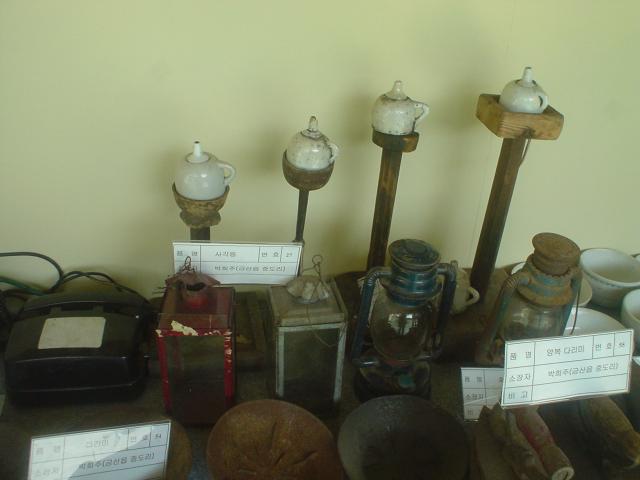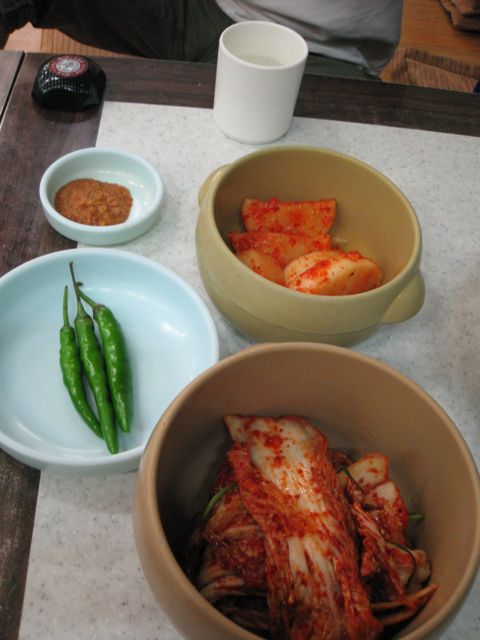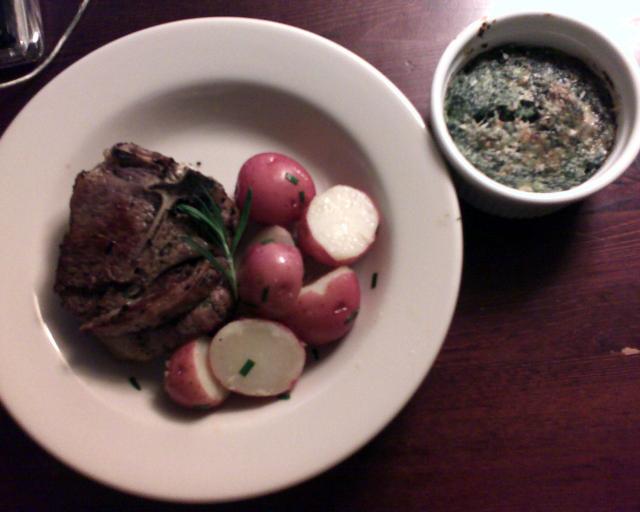-
Posts
22 -
Joined
-
Last visited
Content Type
Profiles
Forums
Store
Help Articles
Posts posted by seisei
-
-
An old phone, old lamps and I have no idea what those tiny teapots on the stick at the back are for.

Doddie,
Those small teapot looking things are very old fashioned oil lamps; they're on tall bases so the light can cast itself fully. I've never seen one in use, but my guess is there is oil on the inside, and you light some sort of wick out of the spout.
Thanks for all of those pictures! All that tteok looked delicious; I hope you got to take some home, either in hand or in your bellies!
Sei
(As for that brownish tan powder on the injulmi tteok, I'm stumped--I've seen it listed as all or a combo of mungbean, soy, and mugwort powders)
-

Also, the gochu (chilies) here, were hot. I’d gotten cocky and had started taken their mildness for granted, immediately grabbing one and dipping it in the ddaenjang as something you’d unconsciously chomp on between dishes.
This stuff bit. It was like a Thai chili, all meanness and spite (and fun to be around). Jason and I both backed up a bit, and then grabbed more (Yoonhi is far more sane than either of us).
Peter, my mother always says you can spot a spicy Korean chili by sight--some inexplicable combination of stubbiness, curvature, and depth of it's green color. I've never gotten this technique down, but those chilis struck me as evil-looking!
-
the bland powder on the rice cake is kinako (don't know the korean name). It's just roasted soy bean powder and is very yummy.
I love that acorn jelly stuff, but its a pain in the butt to pick up with chopsticks bc it always falls apart. However if you are using wooden ones, it is much easier (:
does anyone know how to make acorn jelly?
I think the Korean name for the powder on rice cakes (and sometimes on paat bing su) is call misu garu (misu powder),
For muk, they usually sell acorn/muk powder in stores, which you mix at home with water, heat, and pour out to set, like jello (pm me for a recipe that I have if you like).
Doddie, thanks for the great pictures, and ignore that hubby of yours and keep posting!
-
Peter,
I'm coming out of the deepest, darkness lurkdom to say t h a n k y o u for posting about your trip to Korea! It's the cheapest ticket there I've found yet. Keep it coming!
If you ever need a second daughter, I call dibs.
-
You can usually judge a Korean restaurant by its panchan--some like to throw together a mish mash of odds and ends, and others pay a lot more attention to them as an important element of a meal.
One thing that should be mentioned is that not every table will get the same amount or number of panchan. At least in Korean restaurants in Manhattan, ordering certain dishes will get you less panchan. Yes, sometimes it has to do with the cost of a certain dish, but also with custom. Noodle dishes, for ex., usually are more "self contained' as meals in and of themselves, and a table that orders two noodle dishes may get fewer panchan than the table ordering kalbi. You'll still get panchan, but for the motherload of panchan from a given restaurant, ordering bbq will get you the full complement.
And this may be going into too many specifics, but no table is expected to finish all their panchan. Yes, it's wasteful.
Fat Guy, I think your passage is pretty good--generalist enough, with the most popular panchan.
-
My favorite is their strawberry shortcake. When you get it takeout, it's packaged in a large wide plastic bowl w/lid, typically used in food service for salad--except in this instance, it's packed with fresh whipped cream frosted cake with sliced strawberries, and in a smaller container, macerated strawberry sauce. All plastic salad containers should be so lucky!
-
I would give Pho Viet Huong a big fat no--it's acceptable to go to once in awhile if you live in the city, but there is too little time for you to waste on so-so Vietnamese (esp. being from California). NYC Chinatown is not known for it's Vietnamese food by any means, though it is cheap. Re-direct, stat.
-
Fat Guy,
I love the book idea, and those Asian stats are fascinating. Somehow I always assumed that there were more Koreans in L.A. than in New York, considering the quality of the food out there vs. NY; it's interesting to learn that they simply make up more of the population.
I agree with Sheena that too many people get hung up on bibimbap and bbq and fail to look beyond to the rest of Korean cuisine. I think this may partly have to do with the encyclopedic nature of most Korean restaurants (at least in NY) with menus that go on for nearly a hundred items for pages and pages. I've watched many a friend's eyes glaze over perusing them only to land upon bibimbap.
On the flip side, restaurants specializing in just one or two dishes seem to be a risk as well, for the uninitiated, for fear of a lack of variety or alternatives should the eater not enjoy the house dish or have some sort of "safety" (i.e. bibimbap) to fall back on.
(I think the popularity of bibimbap also is related to the ease with which it can be made vegetarian by excluding beef--not too many other Korean dishes, kimchee included, can be considered safely veggie.)
As a Korean-American, I always think of what I want to eat, and tailor my choice of restaurant to my appetite for a particular dish. In NYC's Koreatown, while the Korean "encyclopedic" menu type restaurants predominate, there is a healthy percentage of "specialized" restaurants focusing on one or two dishes--Chinese style noodles, fried chicken, tofu stew, oxtail soup, etc. If I want bbq (which is rare) or something that one of these specialized places does not provide, I go to the more generalist places. I would say that the percentage of specialized restaurants goes up in Korean neighborhoods in Queens and New Jersey.
-
Edit: I can't believe no one on this thread has mentioned the quintessential korean protein - SPAM! Must have spam at all times.
**Shudder** Many a quickie pan chan in my youth consisted of spam jun--sliced, coated in beaten egg and pan-fried. I can still recall the way the egg coating steamed itself off to reveal the still-pink spam underneath--

-
Some additions I would also recommend (two already mentioned by Peter), especially as they will keep practically forever:
saewoo jut: salted fermented tiny shrimp (comes in jars)
gim/kim: dried laver/seaweed sheets
anchovies, either dried or in powder form
The anchovies are used as flavoring agents in soups, and the shrimp in kimchi, among other uses. They provide that sea salty flavor in many uses, and if you get the whole dried anchovies, can be sauteed for a banchan you can whip up in no time. The salted shrimp can be added to steamed eggs as well, and my favorite is using it as a dip for steamed pork dishes.
As for the gim, briefly toasted over a flame and spread with sesame oil and some salt, it's a great snack, and a delicious addition to the table when you're short on banchan! And you can easily roll your own kimbap.
edited for clarity
-
I've been dying to make the Lemon Cream Tart, but I have a question:
Lacking a stand mixer or a large food processor, would it be alright to mix in the butter using a hand mixer, or will I risk separation? The recipe mentions emulsification to achieve a light creamy texture. Or should I just mix everything in stages in my teeny little cuisinart?
Thanks for the advice, and I love this thread, and the book.
-
The tisane bit threw me off, and the surreal gave it away!
23. Meret Oppenheim, Object
-
3. George Stubbs, Lion Attacking a Horse
http://www.en.utexas.edu/Classes/Moore/gothic/gothPaint2.htm
Click on fifth image on lower left
8. Jasper Johns, Painted Bronze
http://www.aarhuskunstmuseum.dk/boern_og_u...asp?pid=21&id=2
Scroll down for second picture.
Love this topic--coming up with artwork food is harder than one would think! Will ponder some additions.
-
Definitely Via Emilia, no hesitation--
Fresh housemade pasta, particularly tasty tortelloni di zucca for $12. They could easily charge $21. Great attentive service, and beats the pants off of most the E. Village camp (Frank, Supper, Frutti di Mare).
-
My vote for pho is Thai Son (run by Chinese--I know, I know) on Baxter Street in Chinatown. Haven't tried the pho at Pho 32, but their grilled food was pretty "eh."
-

From the top, going clockwise: cherry juice, palm sugar, flour, miso paste, and I'm sure you all guessed the lemon in the middle! Tonight's dinner will feature the palm sugar, but I'll be prepping the miso paste into a marinade for tomorrow's dinner.
Lucky guess, picking you out as a baker--then again, not too many powdery white substances out there.

I vote for extensive work related photos!
(I love your red walls!)
-
Um, long-time listener, first-time caller?
My humble first contribution to this august thread:

Lamb loin chop w/rosemary and garlic, new potatoes with butter and chives, and a ramekin of spinach gratin. Medium rare, I promise--I was too hungry to stop for an interior shot! Believe it or not, its still cold enough in NY for such wintry food.
I could def. use a food porn tutorial from y'all!
(ed. 'cause I'm new at this thing)
-
Raw and cooked green peppers--they taste too "green" as opposed to the sweeter varieties.
Kidneys
Blue cheeses (although I haven't given up entirely)
And I am started to dread the everpresent clumps of mesclun everywhere.
-
Yakitori Totto is a totally unique experience. I would recommend going out of the way for it, and especially so if you're in need of a theatre pick (though then again, the smoke might put off your theatre seating neighbors!).
Didn't sample such an extensive portion of the menu as others, but I do recall being blown away by their oyako don. I confess, I inwardly lamented the safe choices of my dining companions, but this, the most basic of dishes, was the highlight for me--it tasted like true home cooking. The raw egg blended all the elements of rice, chicken, and scallion together beautifully.
-
grrr, this could be anyone! a baker, perhaps?



Kips Bay restaurant
in New York: Dining
Posted
You may be thinking of L'Impero
Haven't been; let us know what you think.
Do I get a prize?